Impacts of Common Urban Development Factors on Cultural Conservation in World Heritage Cities: An Indicators-Based Analysis
Abstract
:1. Introduction
1.1. Trends on the Assessment of Cultural Heritage Management in the Urban Context
1.2. The Use of Common Sustainable Development Indicators
1.3. Current Monitoring Tools for World Cultural Heritage in the Urban Context
2. Methodology
2.1. The Shortlist of Urban Development Common Indicators
2.2. Analysis of Urban Factors within the UNESCO SoC Reporting System
2.3. Systematic Classification of Factors Affecting the Conservation of World Heritage Cities
3. Results
3.1. The Shortlist of Urban Development Common Indicators
3.2. Systematic Classification of Urban Factors Affecting the Conservation of World Heritage Cities
3.2.1. Classification According to Properties’ Description
3.2.2. Management Situation and Impact Analysis
3.2.3. SWOT Analysis
3.2.4. Sustainability Dimensions
4. Discussion and Conclusions
Acknowledgements
Author Contributions
Conflicts of Interest
References
- Guzmán, P.C.; Pereira Roders, A.R.; Colenbrander, B.J.F. Measuring links between cultural heritage management and sustainable urban development: An overview of global monitoring tools. Cities 2017, 60, 192–201. [Google Scholar] [CrossRef]
- Van Oers, R.; Pereira Roders, A. Aligning agendas for sustainable development in the post 2015 world. J. Cult. Herit. Manag. Sustain. Dev. 2014, 4, 122–132. [Google Scholar] [CrossRef]
- ICOMOS. Threats to World Heritage Sites 1994–2004: An Analysis. May 2005. Available online: http://www.icomos.org/world_heritage/Analysis of Threats 1994-2004 final.pdf (accessed on 9 March 2018).
- Turner, M.; Roders, A.P.; Patry, M. Revealing the Level of Tension Between Cultural Heritage and Development in World Heritage Cities. Probl. Ekorozw. 2012, 7, 23–31. [Google Scholar]
- Tanguay, G.A.; Berthold, E.; Rajaonson, J. A Comprehensive Strategy to Identify Indicators of Sustainable Heritage Conservation. Available online: https://www.researchgate.net/publication/266343477_A_Comprehensive_Strategy_to_Identify_Indicators_of_Sustainable_Heritage_Conservation (accessed on 9 March 2018).
- Gravagnuolo, A.; Girard, L.F. Multicriteria tools for the implementation of historic urban landscape. Qual. Innov. Prosper. 2017, 21, 186–201. [Google Scholar] [CrossRef]
- Bandarin, F.; Van Oers, R. (Eds.) Reconnecting the City: The Historic Urban Landscape Approach and the Future of Urban Heritage; Wiley-Blackwell: Oxford, UK, 2014. [Google Scholar]
- Veldpaus, L.; Pereira Roders, A.; Colenbrander, B.J.F. Urban Heritage: Putting the Past into the Future. Hist. Environ. 2013, 4, 18–33. [Google Scholar] [CrossRef]
- Fusco Girard, L. Toward a smart sustainable development of port cities/areas: The role of the “Historic Urban Landscape” approach. Sustainability 2013, 5, 4329–4348. [Google Scholar] [CrossRef]
- Veldpaus, L. Historic Urban Landscapes, Framing the Integration of Urban and Heritage Planning in Multilevel Governance; Eindhoven University of Technology: Eindhoven, The Netherlands, 2015. [Google Scholar]
- Musacchio, L.R. Key concepts and research priorities for landscape sustainability. Landsc. Ecol. 2013, 28, 995–998. [Google Scholar] [CrossRef]
- Reed, J.; Van Vianen, J.; Deakin, E.L.; Barlow, J.; Sunderland, T. Integrated landscape approaches to managing social and environmental issues in the tropics: Learning from the past to guide the future. Glob. Chang. Biol. 2016, 22, 2540–2554. [Google Scholar] [CrossRef] [PubMed]
- UNESCO. UNESCO Recommendation on the Historic Urban Landscape; UNESCO: Paris, France, 2011. [Google Scholar]
- Wu, J. Landscape sustainability science: Ecosystem services and human well-being in changing landscapes. Landsc. Ecol. 2013, 28, 999–1023. [Google Scholar] [CrossRef]
- Axelsson, R.; Angelstam, P.; Degerman, E.; Teitelbaum, S.; Andersson, K.; Elbakidze, M.; Drotz, M.K. Social and cultural sustainability: Criteria, indicators, verifier variables for measurement and maps for visualization to support planning. Ambio 2013, 42, 215–228. [Google Scholar] [CrossRef] [PubMed]
- Musacchio, L.R. The ecology and culture of landscape sustainability: Emerging knowledge and innovation in landscape research and practice. Landsc. Ecol. 2009, 24, 989–992. [Google Scholar] [CrossRef]
- Stem, C.; Margoluis, R.; Salafsky, N.; Brown, M. Monitoring and evaluation in conservation: A review of trends and approaches. Conserv. Biol. 2005, 19, 295–309. [Google Scholar] [CrossRef]
- Pereira Roders, A. How can urbanization be sustainable? A reflection on the role of city resources in global sustainable development. BDC. Bollettino Del Centro Calza Bini 2013, 13, 79–90. [Google Scholar]
- Pendlebury, J.; Short, M.; While, A. Urban World Heritage Sites and the problem of authenticity. Cities 2009, 26, 349–358. [Google Scholar] [CrossRef]
- Bandarin, F.; Van Oers, R. The Historic Urban Landscape: Managing Heritage in An Urban Century; Wiley-Blackwell: Oxford, UK, 2012; Volume 3. [Google Scholar] [CrossRef]
- Zhang, X.; Zhou, L.; Wu, Y.; Skitmore, M.; Deng, Z. Resolving the conflicts of sustainable world heritage landscapes in cities: Fully open or limited access for visitors? Habitat Int. 2015, 46, 91–100. [Google Scholar] [CrossRef]
- Monteiro, V.; Painho, M.; Vaz, E. Is the heritage really important? A theoretical framework for heritage reputation using citizen sensing. Habitat Int. 2015, 45, 156–162. [Google Scholar] [CrossRef]
- Svuom, K.K.; Lisa, T.L.; Mdx, R.H. Assessment of Air Pollution Effects on Cultural Heritage—Management Strategies. In Specific Targeted Research Project (STREP), Priority 8.1 Policy-Oriented Research; Swerea KIMAB: Kista, Sweden, 2007. [Google Scholar]
- Chen, C.F.; Chen, F.S. Experience quality, perceived value, satisfaction and behavioral intentions for heritage tourists. Tour. Manag. 2010, 31, 29–35. [Google Scholar] [CrossRef]
- Zancheti, S.M.; Hidaka, L.T.F. An indicator for measuring the state of conservation of urban heritage sites. In Proceedings of the 6th International Seminar on Urban Conservation: Measuring Heritage Conservation Performance, Recife, Brazil, 29–31 March 2011; pp. 252–264. [Google Scholar]
- Hampton, M. Heritage, local communities and economic development. Ann. Tour. Res. 2005, 32, 735–759. [Google Scholar] [CrossRef]
- Angrisano, M.; Biancamano, P.F.; Bosone, M.; Carone, P.; Daldanise, G.; De Rosa, F.; Franciosa, A.; Gravagnuolo, A.; Iodice, S.; et al. Towards operationalizing UNESCO Recommendations on “Historic Urban Landscape”: A position paper. Aestimum 2016, 165–210. [Google Scholar] [CrossRef]
- Nijkamp, P. Economic Valuation of Cultural Heritage. In The Economics of Uniqueness; Licciardi, G., Amirtahmasebi, R., Eds.; The World Bank: Washington, DC, USA, 2012. [Google Scholar]
- Patry, M.; Bassett, C.; Leclercq, B. The State of Conservation of the World Heritage Forest Network. In Proceedings of the 2nd World Heritage Forest Meeting, Nancy, France, 11–13 March 2005. [Google Scholar]
- Sutherland, W.J.; Pullin, A.S.; Dolman, P.M.; Knight, T.M. The need for evidence-based conservation. Trends Ecol. Evol. 2004, 19, 305–308. [Google Scholar] [CrossRef] [PubMed]
- Zheng, H.W.; Shen, G.Q.; Wang, H. A review of recent studies on sustainable urban renewal. Habitat Int. 2014, 41, 272–279. [Google Scholar] [CrossRef]
- Tweed, C.; Sutherland, M. Built cultural heritage and sustainable urban development. Landsc. Urban Plan. 2007, 83, 62–69. [Google Scholar] [CrossRef]
- Lyytimäki, J. Evaluation of sustainable development strategies and policies: The need for more timely indicators. Nat. Resour. Forum 2012, 36, 101–108. [Google Scholar] [CrossRef]
- Ness, B.; Urbel-Piirsalu, E.; Anderberg, S.; Olsson, L. Categorising tools for sustainability assessment. Ecol. Econ. 2007, 60, 498–508. [Google Scholar] [CrossRef]
- Tanguay, G.A.; Rajaonson, J.; Lefebvre, J.F.; Lanoie, P. Measuring the sustainability of cities: An analysis of the use of local indicators. Ecol. Indic. 2010, 10, 407–418. [Google Scholar] [CrossRef]
- Mascarenhas, A.; Coelho, P.; Subtil, E.; Ramos, T.B. The role of common local indicators in regional sustainability assessment. Ecol. Indic. 2010, 10, 646–656. [Google Scholar] [CrossRef]
- Singh, R.K.; Murty, H.R.; Gupta, S.K.; Dikshit, A.K. An overview of sustainability assessment methodologies. Ecol. Indic. 2012, 15, 281–299. [Google Scholar] [CrossRef]
- Niemeijer, D.; de Groot, R.S. A conceptual framework for selecting environmental indicator sets. Ecol. Indic. 2008, 8, 14–25. [Google Scholar] [CrossRef]
- Shen, L.Y.; Ochoa, J.; Shah, M.N.; Zhang, X. The application of urban sustainability indicators—A comparison between various practices. Habitat Int. 2001, 35, 17–29. [Google Scholar] [CrossRef]
- Moreno Pires, S.; Fidélis, T.; Ramos, T.B. Measuring and comparing local sustainable development through common indicators: Constraints and achievements in practice. Cities 2014, 39, 1–9. [Google Scholar] [CrossRef]
- Holden, M. Sustainability indicator systems within urban governance: Usability analysis of sustainability indicator systems as boundary objects. Ecol. Indic. 2013, 32, 89–96. [Google Scholar] [CrossRef]
- Mayer, A.L. Strengths and weaknesses of common sustainability indices for multidimensional systems. Environ. Int. 2008, 34, 277–291. [Google Scholar] [CrossRef] [PubMed]
- Hsieh, H.-F.; Shannon, S.E. Three Approaches to Qualitative Content Analysis. Qual. Health Res. 2005, 15, 1277–1288. [Google Scholar] [CrossRef] [PubMed]
- UNESCO WHCUNESCO. World Heritage Centre—List of Factors Affecting the Properties. 2008. Available online: http://whc.unesco.org/en/factors/ (accessed on 20 January 2017).
- OWHC. Projects Database Organization of World Heritage Cities. 2016. Available online: http://www.ovpm.org/en/projects?qt-projects=2#qt-projects (accessed on 15 September 2016).
- Tress, B.; Tress, G.; Décamps, H.; d’Hauteserre, A.-M. Bridging human and natural sciences in landscape research. Landsc. Urban Plan. 2001, 57, 137–141. [Google Scholar] [CrossRef]
- Teller, J.; Keita, A.K.; Roussey, C.; Laurini, R. Urban Ontologies for an improved communication in urban civil engineering projects. CyberGeo 2007, 2007, 1–14. [Google Scholar] [CrossRef]
- Redford, K.H.; Coppolillo, P.; Sanderson, E.W.; Da Fonseca, G.A.B.; Dinerstein, E.; Groves, C.; Mace, G.; Maginnis, S.; Mittermeier, R.A.; Noss, R.; et al. Mapping the conservation landscape. Conserv. Biol. 2003, 17, 647. [Google Scholar] [CrossRef]
- Mascia, M.B.; Pailler, S.; Thieme, M.L.; Rowe, A.; Bottrill, M.C.; Danielsen, F.; Geldmann, J.; Naidoo, R.; Pullin, A.S.; Burgess, N.D. Commonalities and complementarities among approaches to conservation monitoring and evaluation. Biol. Conserv. 2014, 169, 258–267. [Google Scholar] [CrossRef]
- Cassatella, C.; Peano, A. Indicators for the Assessment of Historic Landscape Features. In Landscape Indicators; Cassatella, C., Peano, A., Eds.; Springer: Dordrecht, The Netherlands, 2011; Volume 53, pp. 1–30. [Google Scholar] [CrossRef]
- Westfall, M.S.; de Villa, V. Cities Data Book Indicators for Managing Cities; Westfall, V., de Villa, M.S., Eds.; Asian Develepment Bank: Manila, Philippines, 2001. [Google Scholar]
- Dramstad, W.E.; Fry, G.; Fjellstad, W.J.; Skar, B.; Helliksen, W.; Sollund, M.L.B.; Tveit, M.S.; Geelmuyden, A.K.; et al. Integrating landscape-based values—Norwegian monitoring of agricultural landscapes. Landsc. Urban Plan. 2001, 57, 257–268. [Google Scholar] [CrossRef]
- Bryman, A. Integrating Quantitative and Qualitative Research: How Is It Done? In Mixed Methods; SAGE: Thought Oaks, CA, USA, 2006; Volume II, pp. 93–111. [Google Scholar]
- Lombardi, P.; Stanghellini, S. Assessment methods underlying the planning and development of Modena City’s CSR. Sustain. Urban Dev. 2009, 3, 211. [Google Scholar]
- UNESCO WHC. Managing Cultural World Heritage; UNESCO: Paris, France, 2013. [Google Scholar]
- Helms, M.M.; Nixon, J. Exploring SWOT analysis—Where are we now? J. Strategy Manag. 2010, 3, 215–251. [Google Scholar] [CrossRef]
- Soini, K.; Birkeland, I. Exploring the scientific discourse on cultural sustainability. Geoforum 2014, 51, 213–223. [Google Scholar] [CrossRef]
- Lyytimäki, J.; Rosenström, U. Skeletons out of the closet: Effectiveness of conceptual frameworks for communicating sustainable development indicators. Sustain. Dev. 2008, 16, 301–313. [Google Scholar] [CrossRef]
- Veillon, R. State of Conservation of World Heritage Properties, A Statistical Analysis (1979–2013); UNESCO World Heritage Centre: Paris, France, 2014. Available online: http://whc.unesco.org/en/soc/ (accessed on 9 March 2018).
- Agarwal, R.; Grassl, W.; Pahl, J. Meta-SWOT: Introducing a new strategic planning tool. J. Bus. Strategy 2012, 33, 12–21. [Google Scholar] [CrossRef]
- UNESCO WHC. Managing Natural World Heritage; UNESCO: Paris, France, 2012. [Google Scholar]
- Yu, A.T.W.; Wu, Y.; Zheng, B.; Zhang, X.; Shen, L. Identifying risk factors of urban-rural conflict in urbanization: A case of China. Habitat Int. 2014, 44, 177–185. [Google Scholar] [CrossRef]
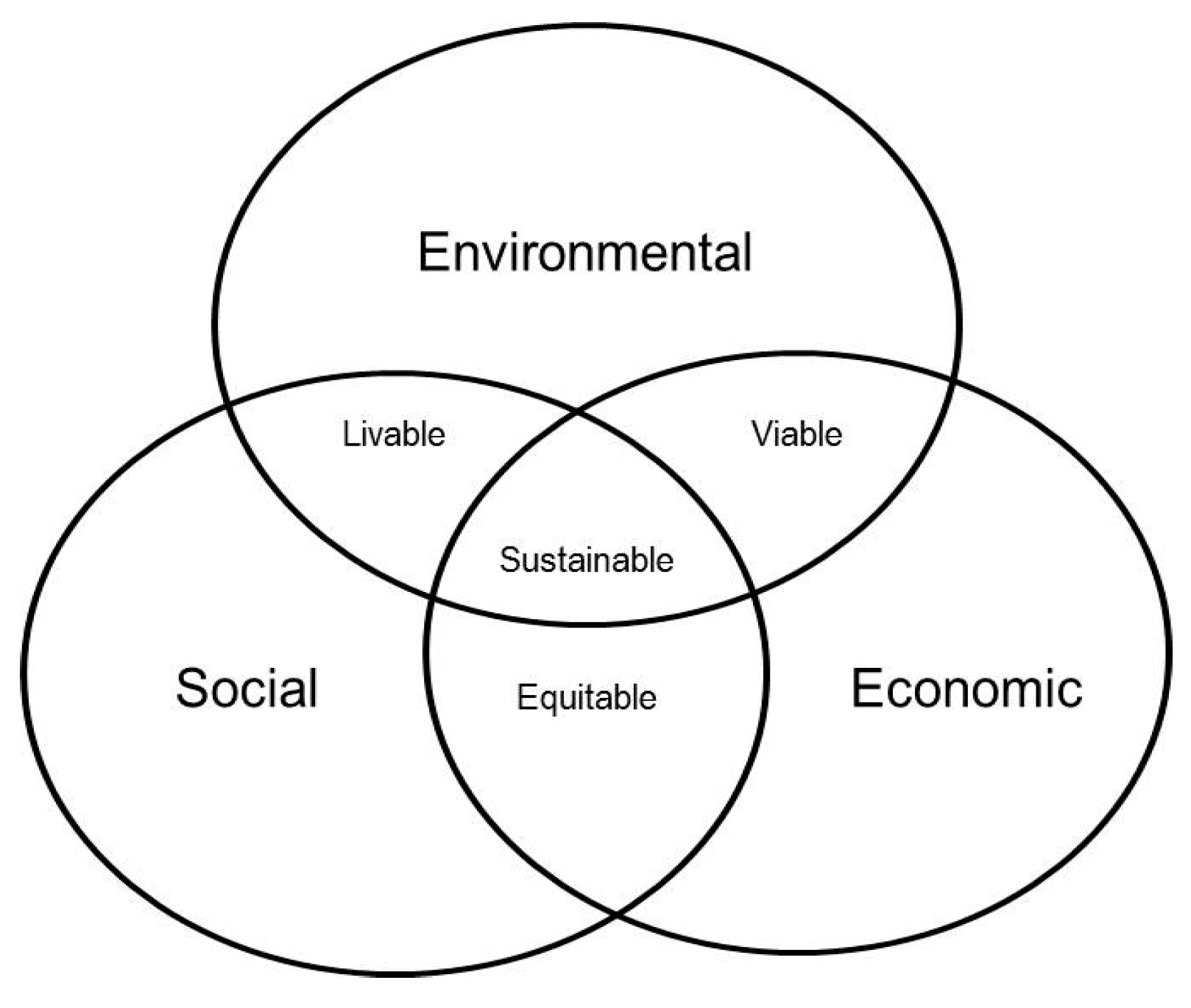
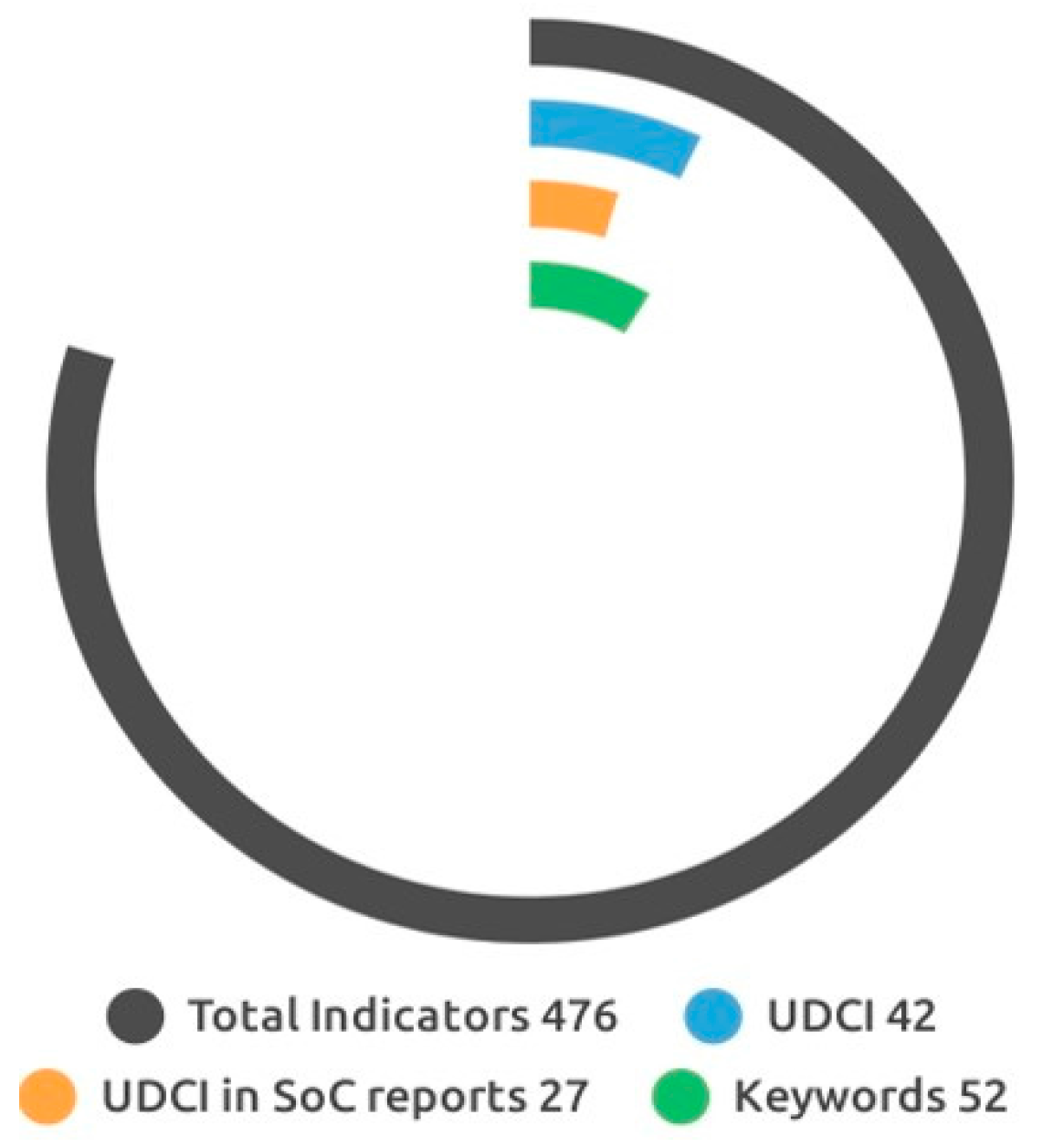
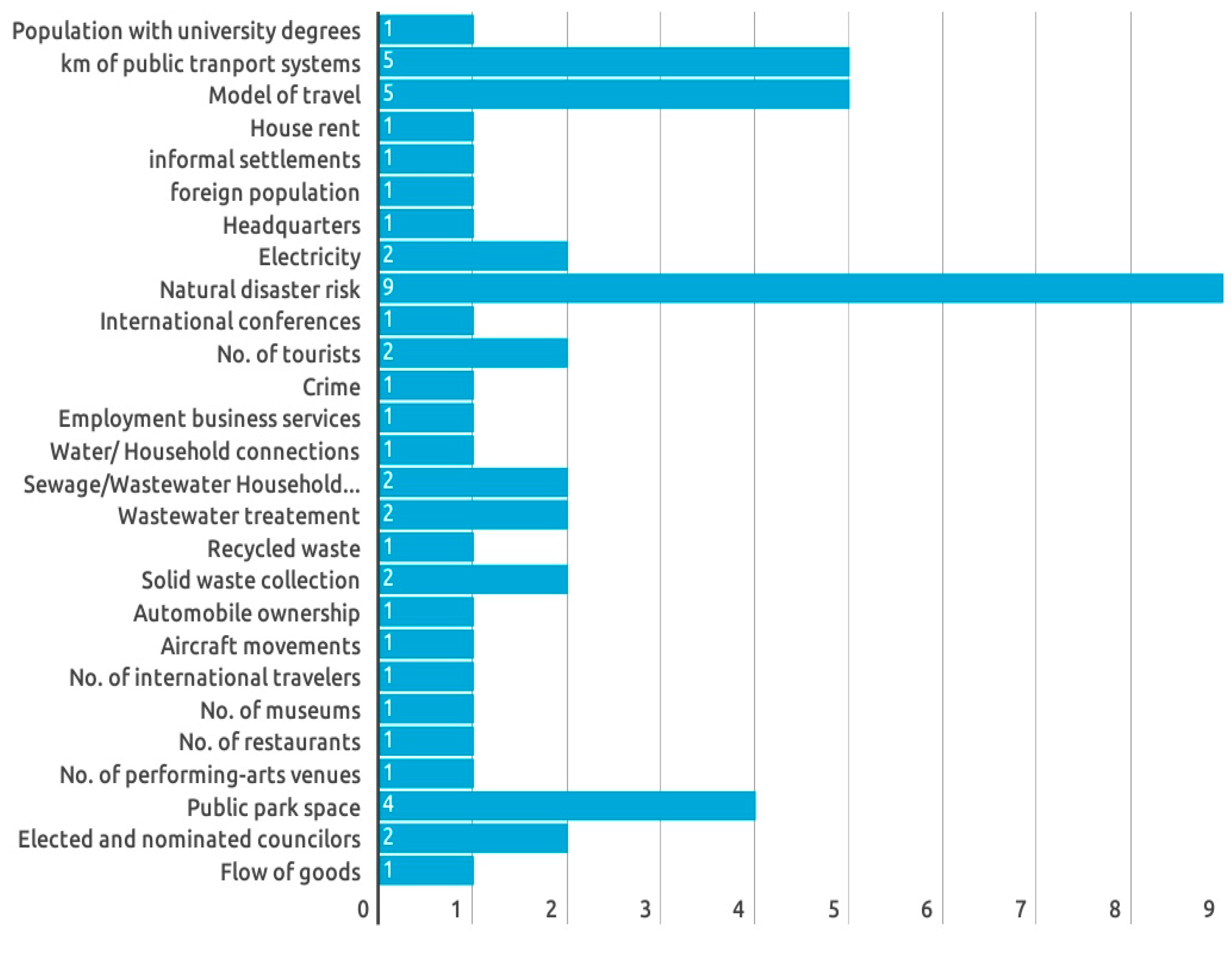
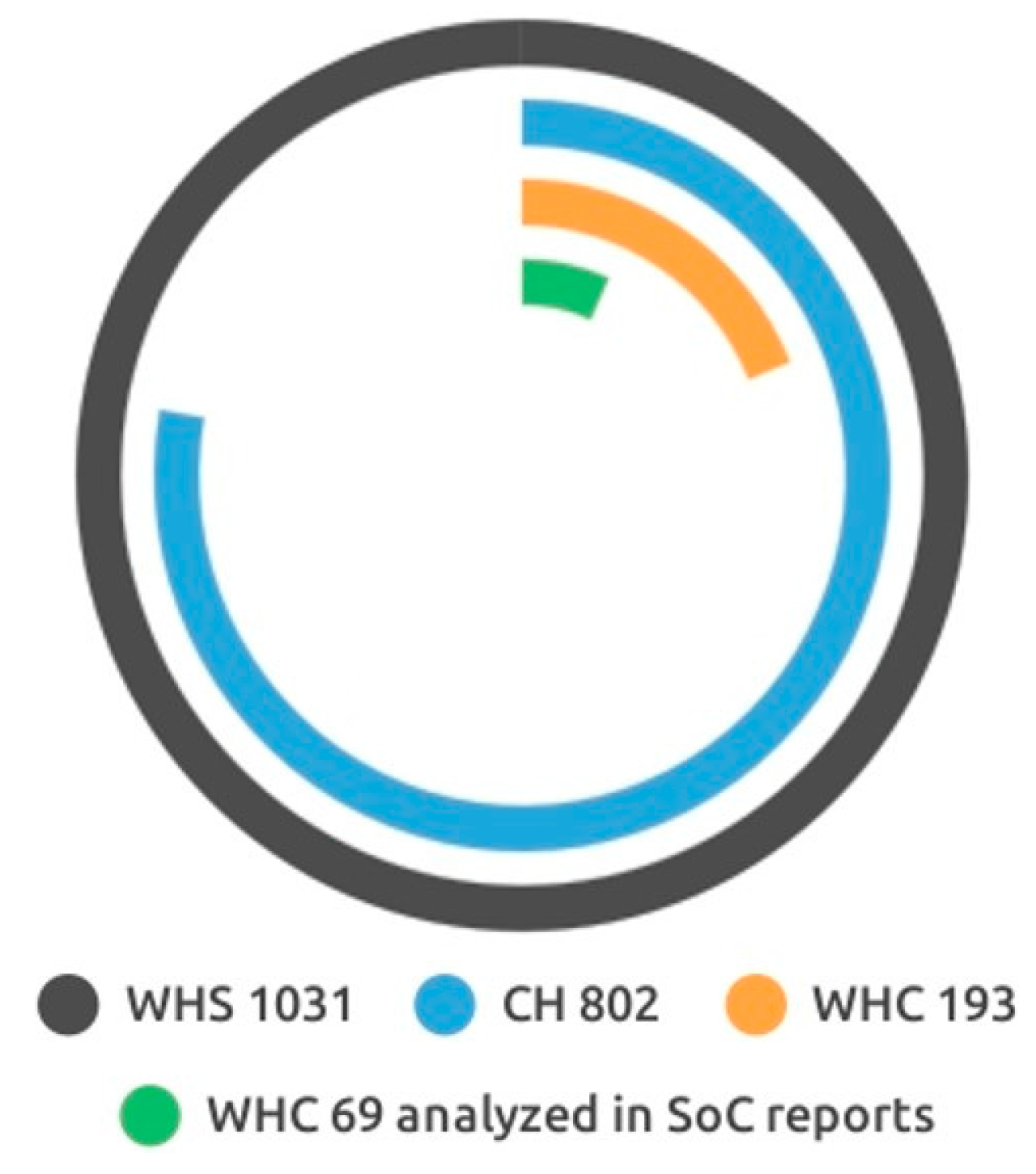
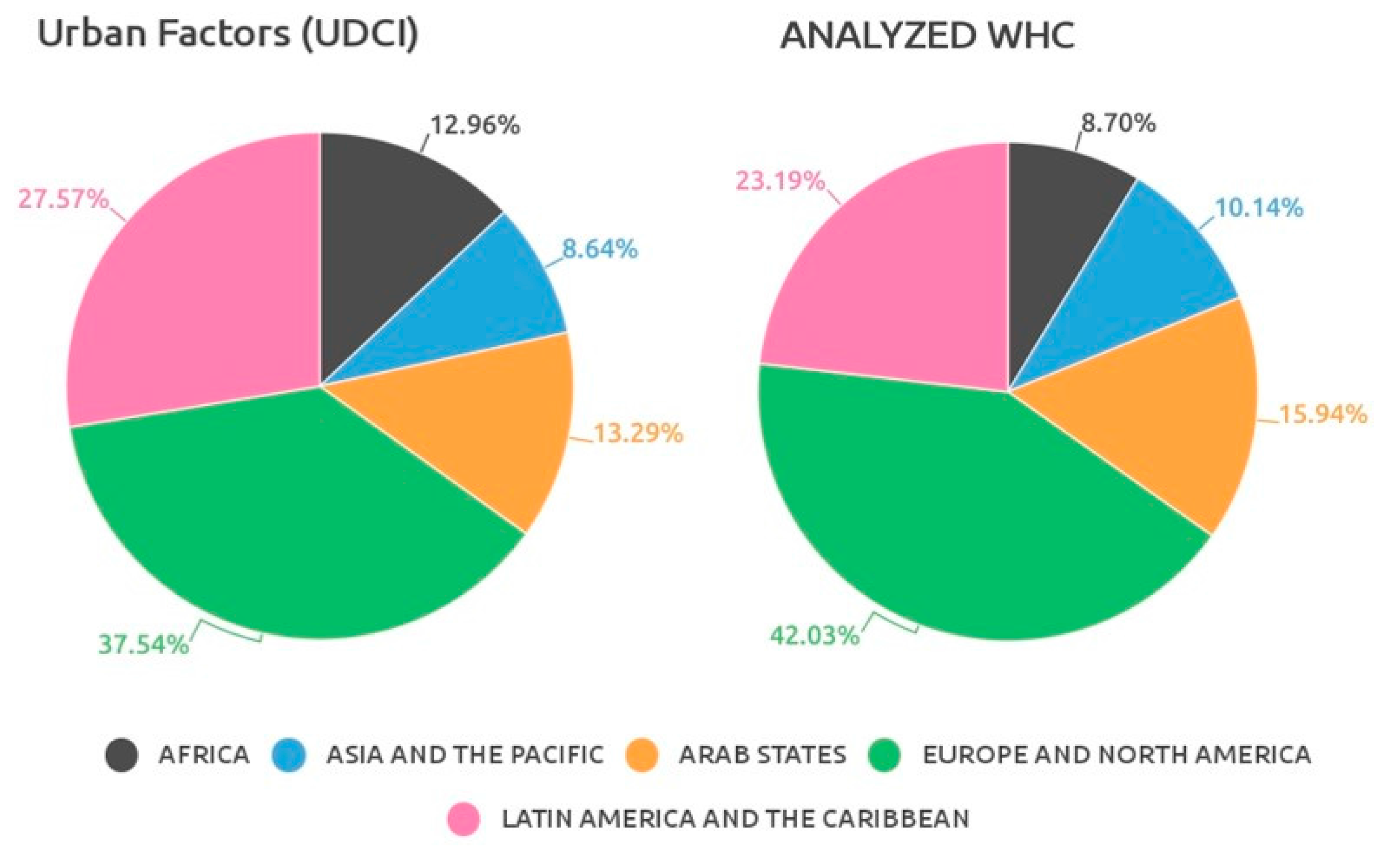

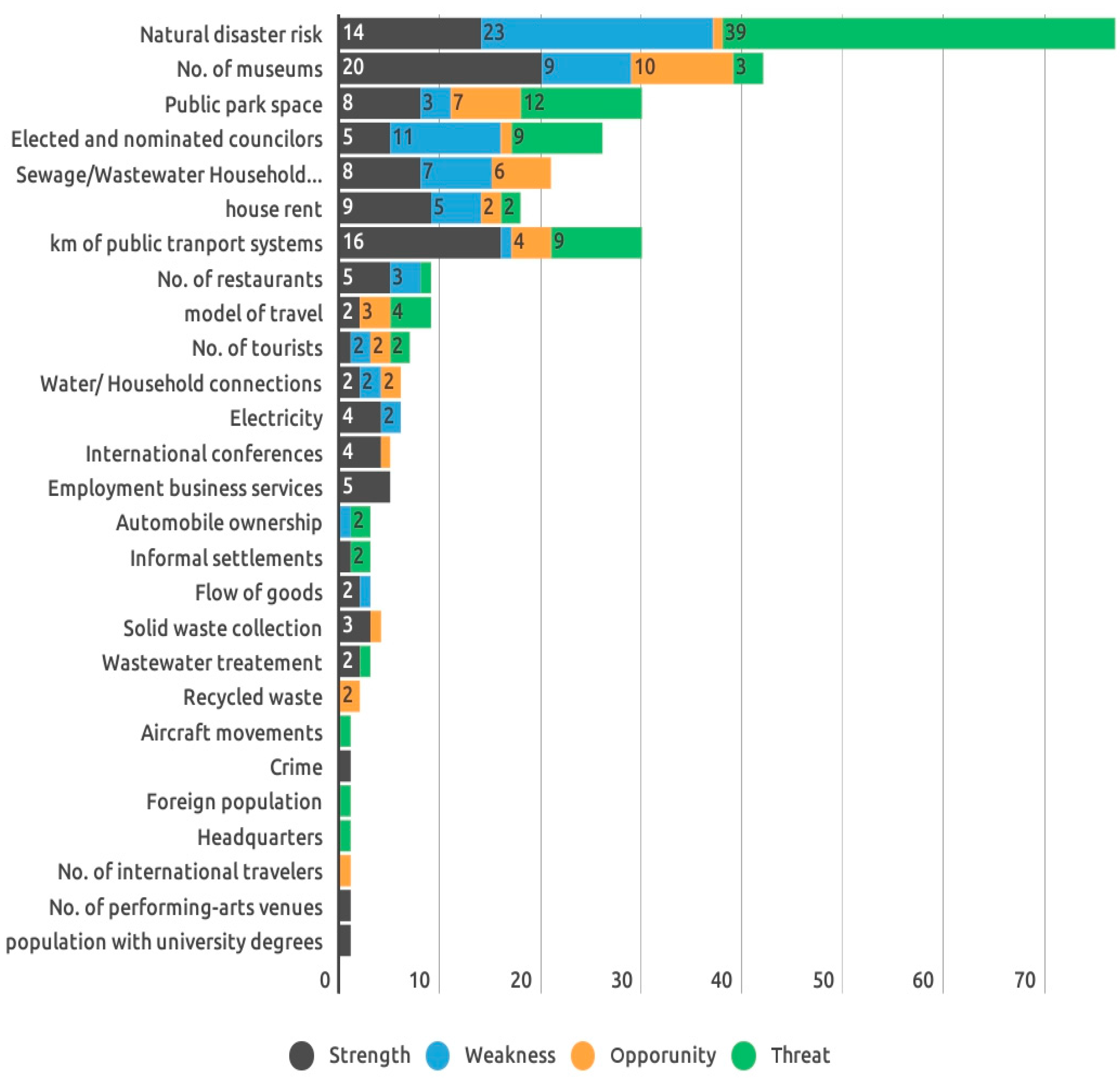

| Type of Reports | Focus | Sources | No. of Ind. |
|---|---|---|---|
| City Rankings | Hierarchical listing of cities according to their economic sustainability, competitiveness, and positioning within the global urban market. |
| 59 |
| 27 | ||
| 36 | ||
| Global Cities’ Cultural Supply | Cultural policies strategies. |
| 60 |
| City Management Performance | Holistic overview of sustainability progresses, trends and the establishing urban strategies and policies. |
| 76 |
| 39 | ||
| 143 | ||
| 36 |
| Coding Dimension | Coding Items and Definitions |
|---|---|
| 41 UDCI | 1. Indicator generic name |
| 2. Keywords | |
| Property Description | 3. Name of the property |
| 4. Geographical Region | |
| 5. Africa (AFR) | |
| 6. Arab States (ARB) | |
| 7. Asia and the Pacific (APA) | |
| 8. Europe and North America (EUR) | |
| 9. Latin America and the Caribbean (LAC) | |
| 10. Report year | |
| Management Situation Analysis | 11. External Factor |
| 12. Internal Factor | |
| Impact Analysis | 13. Positively affecting conservation actions |
| 14. Negatively affecting conservation actions | |
| Sustainability Dimensions | 15. Economic: |
| Permitting continuing compatible land uses or economic activity, such as tourism revenues, reuse of buildings, management capabilities [55], i.e., when the economic benefits or threats are mentioned (costs of conservation actions, funding, expenses or references to economic activities and functions, etc.) | |
| 16. Environmental: | |
| When related to protecting the natural environment (particular ecosystems in and around properties), gradual changes due to geological, climatic or other environmental factors, threats, and protection from natural hazards, pollution, efficiency and improvement of natural resources, environmental friendly interventions, etc. [55] | |
| 17. Social: | |
| When related to social equity, by maintaining strong links with communities and contributing to society, professional creation, reception or participation activities but also actions related to government will, consultation processes, human resources, local population or civil society participation, improvement of life quality. Protecting less tangible assets within properties (communities, cultures, and knowledge) [55]. |
| Indicator | Dimensions | Freq. |
|---|---|---|
| Sustainable | 4 |
| Sustainable | 4 |
| Equitable | 4 |
| Equitable | 4 |
| Equitable | 4 |
| Sustainable | 3 |
| Sustainable | 3 |
| Sustainable | 3 |
| Sustainable | 3 |
| Sustainable | 3 |
| Sustainable | 3 |
| Sustainable | 3 |
| Sustainable | 3 |
| Sustainable | 3 |
| Sustainable | 3 |
| Sustainable | 3 |
| Sustainable | 3 |
| Sustainable | 3 |
| Sustainable | 3 |
| Equitable | 3 |
| Equitable | 3 |
| Equitable | 3 |
| Equitable | 3 |
| Equitable | 3 |
| Equitable | 3 |
| Equitable | 3 |
| Equitable | 3 |
| Equitable | 3 |
| Equitable | 3 |
| Equitable | 3 |
| Economic | 3 |
| Equitable | 3 |
| Equitable | 3 |
| Equitable | 3 |
| Equitable | 3 |
| Equitable | 3 |
| Equitable | 3 |
| Equitable | 3 |
| Equitable | 3 |
| Equitable | 3 |
| Equitable | 3 |
© 2018 by the authors. Licensee MDPI, Basel, Switzerland. This article is an open access article distributed under the terms and conditions of the Creative Commons Attribution (CC BY) license (http://creativecommons.org/licenses/by/4.0/).
Share and Cite
Guzman, P.; Pereira Roders, A.R.; Colenbrander, B. Impacts of Common Urban Development Factors on Cultural Conservation in World Heritage Cities: An Indicators-Based Analysis. Sustainability 2018, 10, 853. https://doi.org/10.3390/su10030853
Guzman P, Pereira Roders AR, Colenbrander B. Impacts of Common Urban Development Factors on Cultural Conservation in World Heritage Cities: An Indicators-Based Analysis. Sustainability. 2018; 10(3):853. https://doi.org/10.3390/su10030853
Chicago/Turabian StyleGuzman, Paloma, Ana R. Pereira Roders, and Bernard Colenbrander. 2018. "Impacts of Common Urban Development Factors on Cultural Conservation in World Heritage Cities: An Indicators-Based Analysis" Sustainability 10, no. 3: 853. https://doi.org/10.3390/su10030853
APA StyleGuzman, P., Pereira Roders, A. R., & Colenbrander, B. (2018). Impacts of Common Urban Development Factors on Cultural Conservation in World Heritage Cities: An Indicators-Based Analysis. Sustainability, 10(3), 853. https://doi.org/10.3390/su10030853




